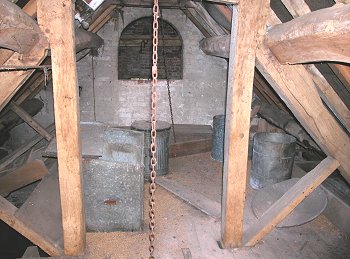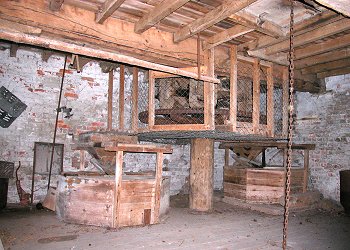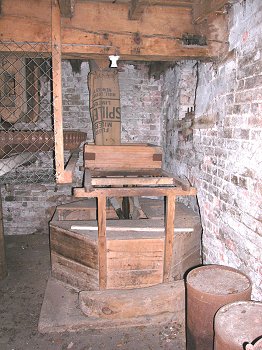| Although not actually in Penn itself, lying as it
does between Penn and Wombourne, Wodehouse Mill is a
fascinating place and worthy of inclusion in this
section. |
|

The front of the mill. |
Anyone taking a
stroll along the bottom of Penn Common is likely to come
across Penn Brook, a small stream that gently flows
westwards across the common, from its source in the
Colton Hills. The stream is the main tributary of the
Wom Brook, after which the village of Wombourne takes
its name.
The stream
aimlessly meanders on its course and seems to have been
untouched by human activity, but in reality nothing
could be farther from the truth. It is part of an
ancient, well-managed water supply.
The Wodehouse
estate lies on the south-western corner of the common,
and when there, the stream enters Wodehouse Mill Pool, a
dammed reservoir that supplies an overshot waterwheel in
Wodehouse Mill and ensures that a sufficient supply of
water is always available. |
| The mill stands next to Wodehouse
Farm, and although no longer in use, is in a wonderful
state of preservation. It
has been through several transformations during its long
life and is first recorded in 1570 as a fulling mill.
Some time later it was possibly converted to a corn
mill, because in 1672 a malthouse stood on part of the
Wodehouse estate, that had been converted from a water
corn mill. |

Wodehouse Mill Pool. |
|

The waterwheel. |
By 1693 it was a
corn mill again, until a tragic fire in 1814 badly
damaged the building. The fire started between one and
two o’clock on the morning of Wednesday 20th
April, and appears to have been started deliberately. A
reward of 100 guineas was offered to any person who
could supply information that would lead to the
conviction of the perpetrator.
The mill was
rebuilt in 1840 and used for grinding corn for cattle
feed. It remained in use as such until 1976, since which
time it has been idle. Power is obtained from an
overshot waterwheel consisting of two cast iron wheels,
between which are bolted sheet steel paddles. The whole
structure is about 12 feet in diameter and is fed from
an overhead water tank. Water is piped into the tank
from Wodehouse Mill Pool, and after turning the wheel it
flows into a lower mill pond. |
|
The building has
three storeys, and an upper service floor in the roof
space.
Sacks of corn
are hoisted to the top floor through trap doors, by a
hoist chain, and when there the corn is tipped into one
of two chutes that feed the two grindstones below.
The third
storey, the sack floor, is an open space where sacks of
corn can be stored before being transported to the top
floor for use. |

The top floor. |
|

Part of the hoist windlass on the
sack floor. |
The second floor is where the
grinding takes place, in the form of two grindstones
that were made by Kay & Hilton, Fleet Street, Liverpool,
in 1853.
When ground and re-bagged, the
corn can either be returned to the sack floor for
storage or lowered onto a cart via an external second
floor door.
All of the machinery still
survives and appears to be in good condition, apart from
the paddles on the waterwheel, which have mostly rusted
away.
Unfortunately the mill is not
accessible to the public, as it is on part of the
Wodehouse estate. |
| The two grindstones and gear
mechanism on the first floor. |
 |
 |
The right-hand grindstone with
the feed chute above. |
|
There were
several other mills in the area. Ludes Mill, listed in
1483, probably stood on the Wom Brook near to the
Wodehouse. Two others are recorded at Wombourne in 1086,
and together were worth 4 shillings. They were later
listed in 1483 and described as the mill of Wombourne
and the mill of the lord of Dudley. A mill is recorded
as being on the stretch of brook in the village of
Wombourne in 1664 and another stood in Mill Lane in the
early 19th century. This was a corn and blade
mill, and later a blade mill only.
In 1815 a mill
known as Ham Mill was situated to the west of Gravel
Hill and disappeared some time after 1860, the miller
was George Prior. Another mill called Trill Mill was to
be found in Orton in 1294, it is probably Caldewall mill
that is recorded in 1562 and 1581.
In 1623 Thomas
Barnesley had a water mill in the manor of Wombourne and
Orton, and was a tenant of Sir Hugh Wrottesley. Finally
Heath Forge was advertised for letting in 1814 and
described as a mill in 1820. It ceased to work in about
1930 and was demolished in the 1970s.
Although the
area today is one of rural tranquillity, not that long
ago it was a hive of industry, where the inhabitants
efficiently used the natural resources that were to
hand. In those days Wom Brook was a working stream
and parts of its banks must have been busy and noisy
places with all of the activity going on.
Most of the
details used here were taken from volume 20 of
Victoria County History:
A History of Staffordshire. I would like to thank Mr.
and Mrs. Phillips of the Wodehouse for permission to
write this article. |
 |
Return to
the
previous page |
|